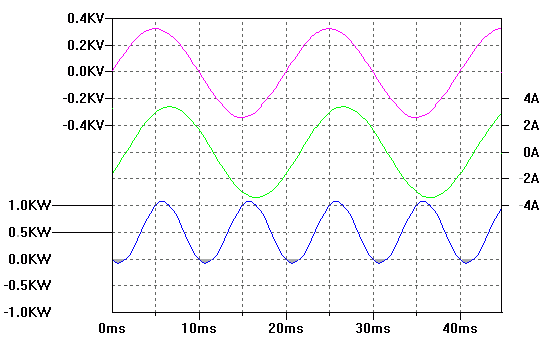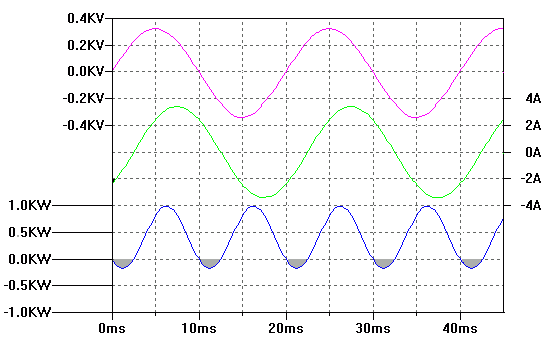|
Clearly no one would put just a capcitor or inductor on the end of a mains lead. It would be pointless. However that is exactly what happens when a transformer is there with no load on it. An unloaded transformer is an inductor and nothing more.
This isn't really relevant because the reactance of a transformer is so high that it draws very little current with no load on it. However it does serve to show that such things do happen in the real world.
Where all this becomes very relevant is with certain types of load that have two components to the way they draw current. They have a resistive component (that does useful work) and a reactive component (that does no useful work).
A typical example of this is a powerful electric motor such as in a vacuum cleaner or large pump.
In this case the graph will show some phase difference between the current and voltage but never as high as 90 degrees as we previously saw.

Here we have a graph of a piece of equipment that has inductance and resistance. This now shows a 30 degree lagging current. You can see the small portion of returned power shaded grey on the power trace.
Again it draws exactly the same current as before at 2.3 amps. Therefore Apparent Power is still 230Volts * 2.3Amps = 530VA. Power Factor in this case is Cosine of 30 degrees = 0.866 so 530VA * 0.866 = 458 Watts.
So here we have an apparent power of 530VA. A Power Factor of 0.866 and therefore a Real Power of 458 Watts. The other 72VA is returned to the source.
The cabling, generator, inverter etc still have to be designed to handle the full current even though the Wattage rating is somewhat lower than this current would imply.
Finally a load that is a bit nastier. This one has a 45 degree phase lag, therefore a Power Factor of cosine 45 = 0.707 so (the current being the same again) 530VA * PF 0.707 = 375 Watts Real Power.

You can see the grey shaded area is a bit bigger in this graph representing the extra power returned to the source.
So I hope that was clear and that you now understand the huge difference between Apparent Power (measured in VA) and Real Power (measured in Watts).
A purely capacitive (or inductive) load (which therefore has PF = 0) that draws 10 amps would have an Apparent Power of 2300VA. A Real Power (ie doing useful work) of ZERO but would still shut down a 2000 watt inverter or stall a 2000 Watt generator.
And that sums up the problem of Power Factor, Apparent Power and Real Power as far as phase shift in the current is concerned.
Which leaves one last matter to be dealt with. That of distorted current draw waveforms......
|
Page last updated 02/04/2008.
Website best viewed on a computer of some sort.